in November 26, 2019
Openlab VLF Observatories Report, by Renato Romero
In 2019, on a fall night in November 26, a magnitude 6.2 Mw earthquake struck the Northern coast of Albania. The seismic shaking was strong, it was felt also in near countries like Bulgaria, Bosnia and Herzegovina, Croatia, Greece, Italy, Kosovo, Montenegro, Serbia and Northern Macedonia. The epicenter was located 21 km away from Durres and it is the earthquake with the most victims in Albania: 51 dead and dozens injured, with collapsed houses and severely damaged infrastructures. With this paper we report the surveys carried out by the network "Openlab VLF Observatories" coordinated by www.vlf.it. The analysis focuses on the origin time of the earthquake, and on the hours and days that preceded it, in searching for some possible correlation of electric or magnetic emissions at low frequency, during and before the earthquake.
Seismic event details of the event are reported by INGV, the NATIONAL INSTITUTE OF GEOPHYSICS AND VULCANOLOGY in Italy: http://cnt.rm.ingv.it/en/event/23487611
Here is a brief summary of the main data:
- Event-ID: 23487611
- Magnitude MW 6.2
- Date/time: 26-11-2019 ore 02:54:11 (UTC)
- Area: Northern Albanian coast (Albania)
- Coordinates (lat, lon): 41.37, 19.47
- Dept: 10 km.
Map taken from Google Map:
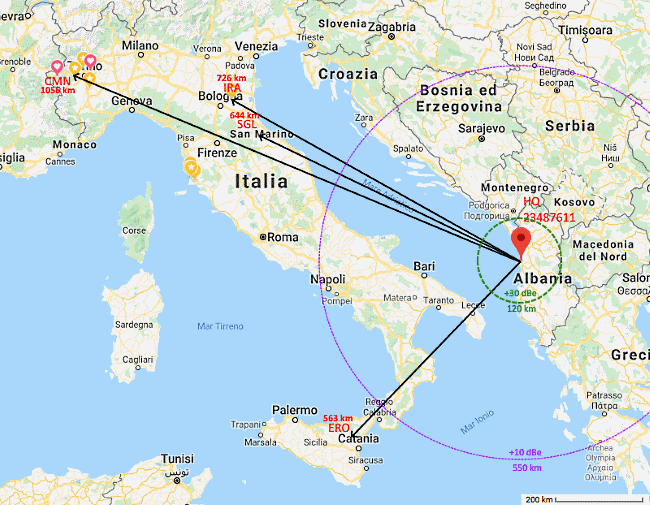
On the right side of the map the epicenter of the earthquake. The first green circle, outlined at 120 km in circumference, circumscribes the "green area" with the maximum possibility of detecting precursors with a 6.2 Mw earthquake, according to the Radiosismic Index, developed in 2015 and described in the article http://www.vlf.it/opera_2015/opera_2015.html. The second circle, in a purple dotted line at 550 km, circumscribes the gray area, where instead the possibilities of detecting precursors become very remote, and the results obtained are still doubtful and controversial.
Our workstations which are placed:
- CMN Cumiana, in North West Italy, 1058 km far away from epicenter
- IRA, located NORTHERN CROSS RADIOTELESCOPE of Medicina, North East Italy, 726 km far away from epicenter
- SGL, Sogliano, North East Italy, 644 km far away from epicenter
- ERO, Etna Volcano, Sicly, South Italy, 563 km far away from epicenter
...are therefore found outside this area. We have decided to perform the analysis of the collected data anyway. The search of possible signals associated with the earthquake will give us the opportunity to validate the radiosismic indicator as a tool for this type of research. The protocol followed was the same as for the OPERA 2015 project, which in 2015 monitored the electric and magnetic field emissions during the 45 most significant earthquakes of that year.
Below there is the event recorded by a vertical geophone at the most remote monitoring station, located in the north-west Italy near the french border. The seismic signal was recorded by the same sound card with the electric field so the two signals can be easily associated. The Schumann resonances and the static coming from the storms can be identified in the spectrogram below:
The zero time of the seismic event 23487611 is marked by the red vertical line.
The seismic signal recorded by the geophone has been accelerated 29 times to make it audible. Two signal waves can be distinguished, the first determined by the body waves, the second by the shear waves, arriving at the Cumiana monitoring station, almost two minutes after the earthquake.
Click on the icon below to listen to the earthquake:
Storm map, with last two hours activity, before the event:
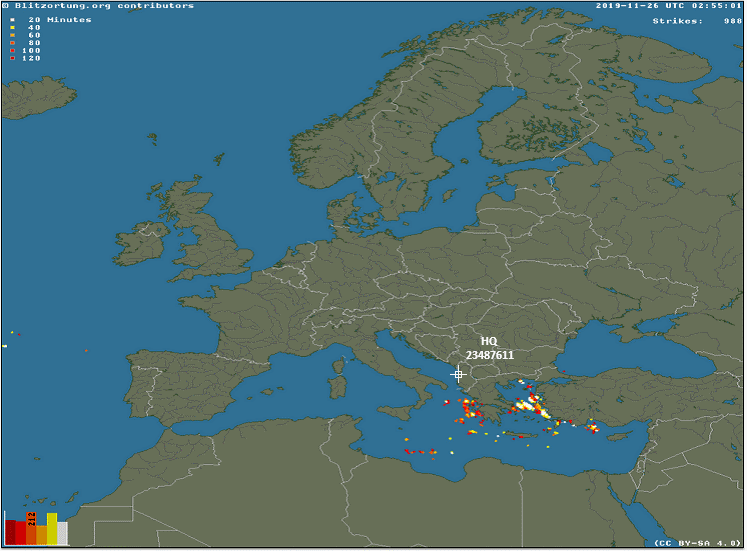
Courtesy of Biltzortung http://it.blitzortung.org/historical_maps.php?map=10
Below are the monitoring data collected by the stations, equipped for receiving signals at very low frequency in various ways: induction coil and aerial loops for the magnetic field, Marconi antennas for the electric field and geophones to detect the wave seismic.
Published data is owned by www.vlf.it and station operators, but can be republished by indicating the source of origin.
Data analisys from Cumiana monitoring station
CMN, 1056 km from the event (http://www.vlf.it/cumiana/livedata.html)
Radio seismic index: 2.29 dB
Hourly multistrips vertical geophone detection:
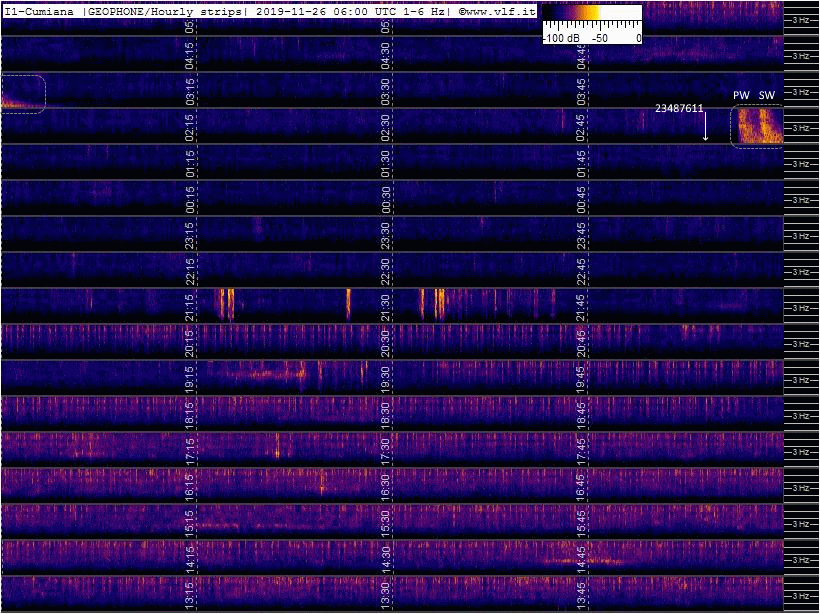
Event ID: 23487611 marked with a white vertical arrow, followed two minutes later by a pressure wave and a surface wave, which last for over 5 minutes. Signals in the previous hours, relating to the afternoon of the previous day, up to 20:50, are generated by industrial activity, 0.5 km from the receiving station.
VLF electric field, detected with big marconi antenna, 11 m high with 30m long top hat.
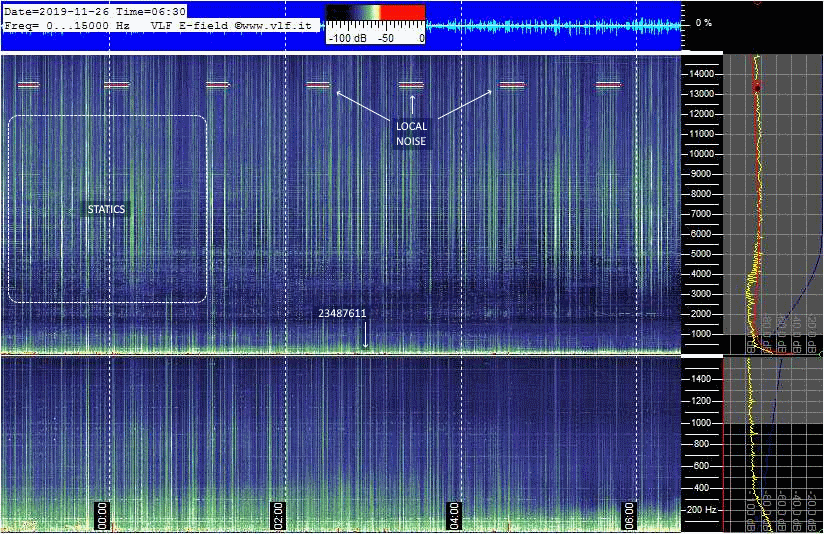
Event ID: 23487611 marked with a white vertical arrow. Strong static throughout the spectrogram, generated by remote storm activity and a local 13.5 kHz periodic signal. No strange signal before or during the event, related to the earthquake.
Vertical geophone and electric field detected with marconi antenna.
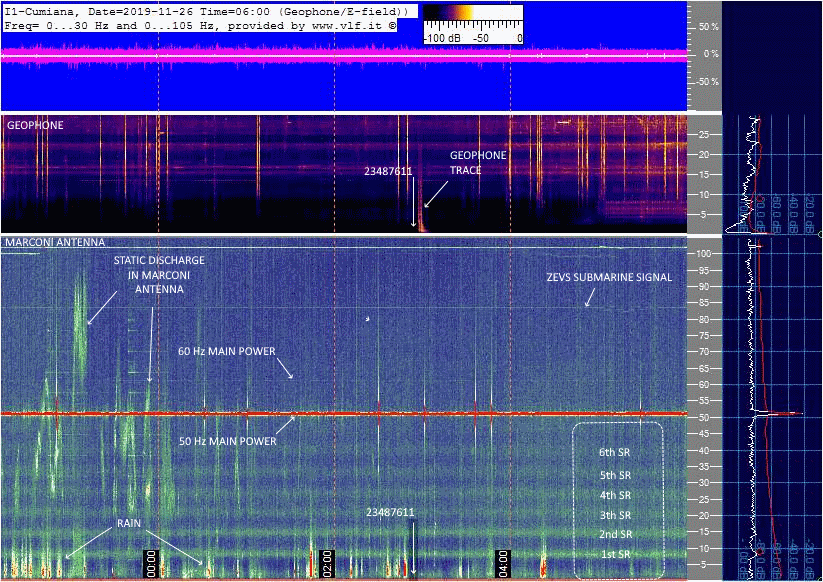
Event ID: 23487611 marked with a white vertical arrow. In the electric field spectrogram we can see: Schumann resonances, 82 Hz ZEVS signal directed to the Russian submarine, main power at 50 Hz, main power at 60 Hz weak, static discharge on the Marconi antenna caused by a high level static fileld and some rain events marked by a signal below 5 Hz. No RF signal related to the seismic event.
Multistrip daily view of Electric field, detected with marconi antenna.
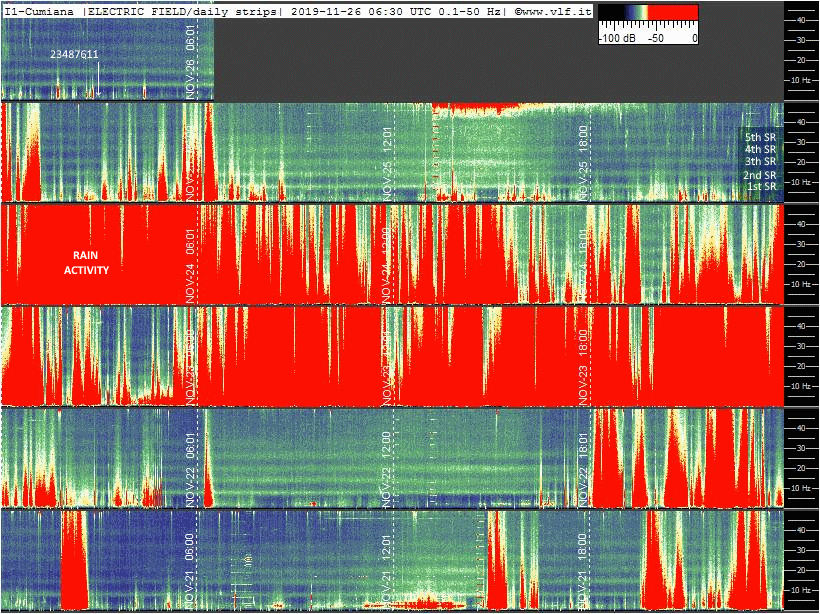
Event ID: 23487611 marked with a white vertical arrow, top left. Here we see how the rain can blind the reception of the low-frequency electric field. Schumann's resonances are strong and clear when it's not raining. No RF signal related to the seismic event.
Plot levels of: vertical geophone, electric field at 10 Hz, electric field at 100 Hz and second Schumann resonace frequency.
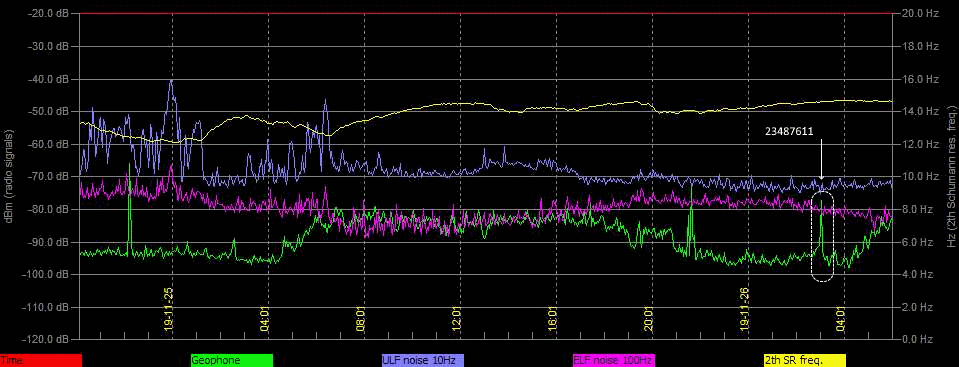
Event-ID: 23487611 marked with white vertical arrow. The trend over time is the same as in the previous days. No variations correlated with earthquake event.
Magnetic field detected with two orthogonal induction coils, RDF spectrogram:
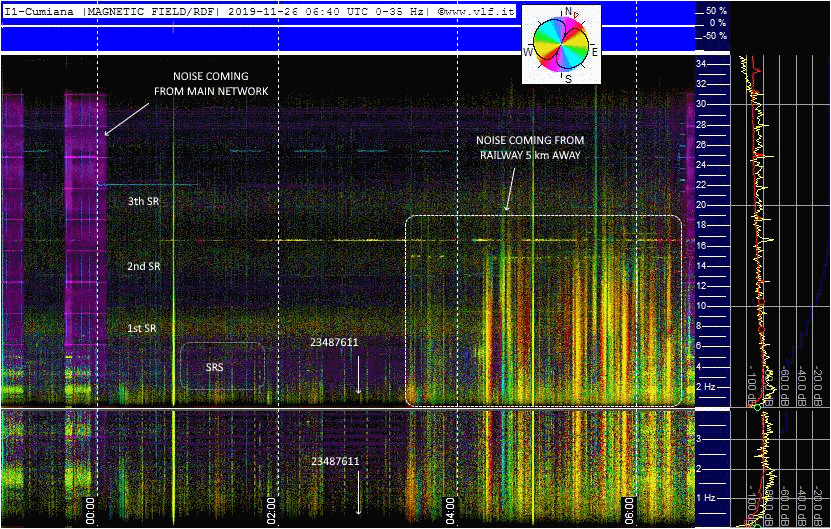
Event ID: 23487611 marked with a white vertical arrow, in the center of the spectrogram. The first three Schumann resonances are visible, monochromatic broadband noise coming from the electric network, weak SRS. Starting at 4:30, the band is occupied by the signals of the first morning trains passing on a nearby railway line, located 5 km from the station. No RF signal related to the seismic event.
Multistrips hourly view of Magnetic field, detected with two orthogonal induction coils, RDF spectrogram:
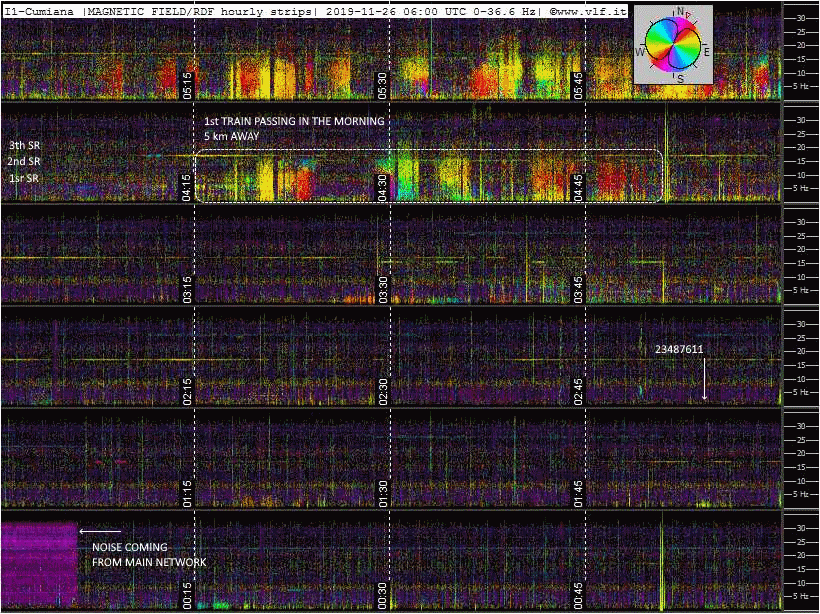
Event-ID: 23487611 marked with white vertical arrow on the right side of the spectrogram. The same signals of the previous spectrogram but with greater temporal resolution. No RF signals correlated with earthquake event.
Multistrips daily view of Magnetic field, detected with two orthogonal induction coils, RDF spectrogram:
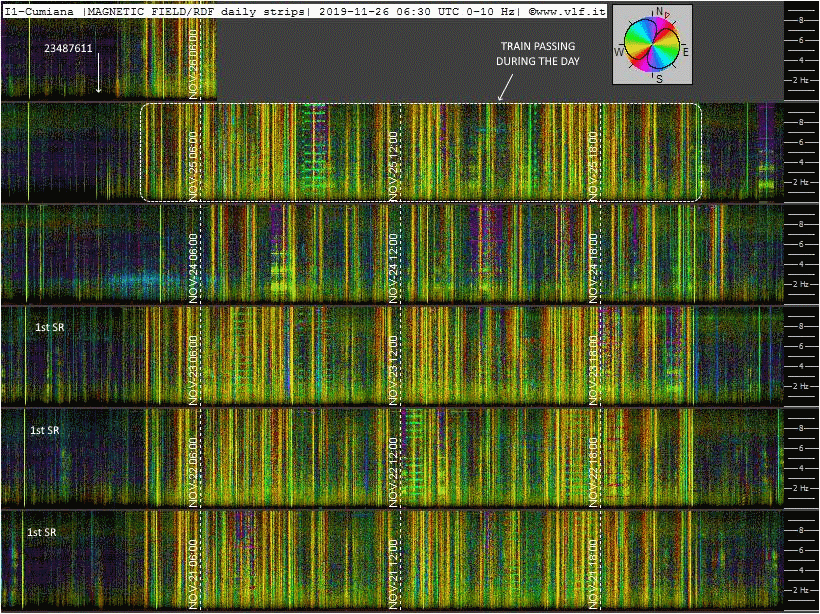
Event-ID: 23487611 marked with white vertical arrow. During the day the band is saturated by the signals coming from the trains. During the night the railway line does not work, and the natural backgound, made by Schumann resonances, becomes visible again. No RF signals correlated with earthquake event, also in comparison with the previous days.
Data analisys from NORTHERN CROSS RADIOTELESCOPE monitoring station
IRA, 726 km from the event (http://www.ciph-soso.net/vlf_it/medicina_live.html)
Radio seismic index: 7.17 dB
Multistrips hourly view of Magnetic field, detected with induction coil:
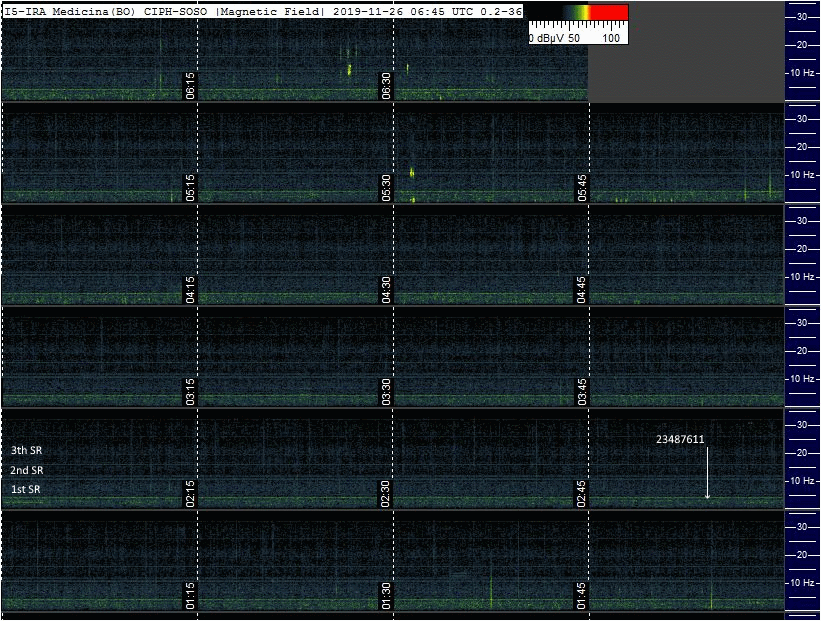
Event-ID: 23487611 marked with white vertical arrow. Weak Schumann resonances can be seen on the background. No RF signals correlated with earthquake event.
Multistrips daily view of Magnetic field, detected with induction coil:
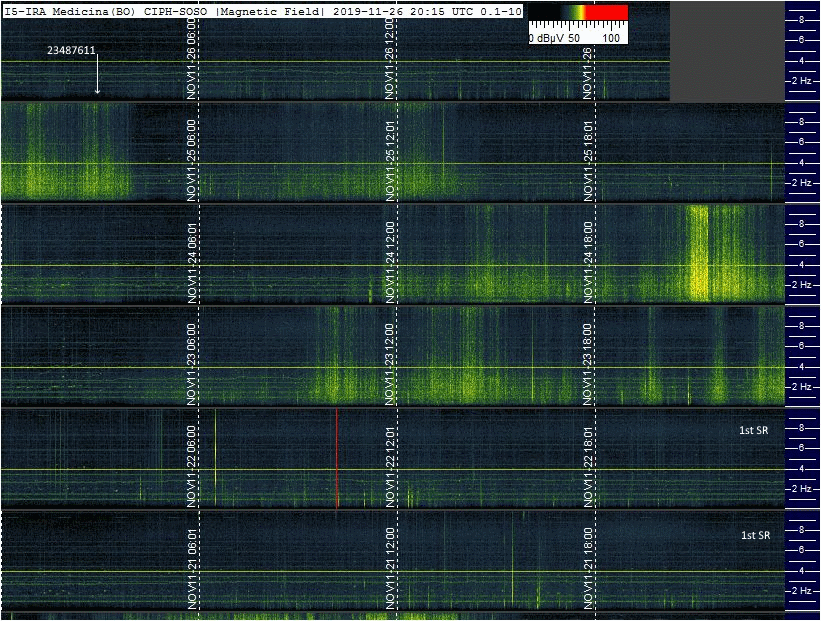
Event-ID: 23487611 marked with white vertical arrow, on top left. First Schumann resonance, almost always visible. Increased background noise in the previous days due to local storm activity. No RF signals correlated with earthquake event.
Data analisys from ROMAGNA ULF ELF VLF monitoring station
SGL, 644 km from the event
Radio seismic index: 8.73 dB
Hourly multistrips RDF horizontal geophone detection:
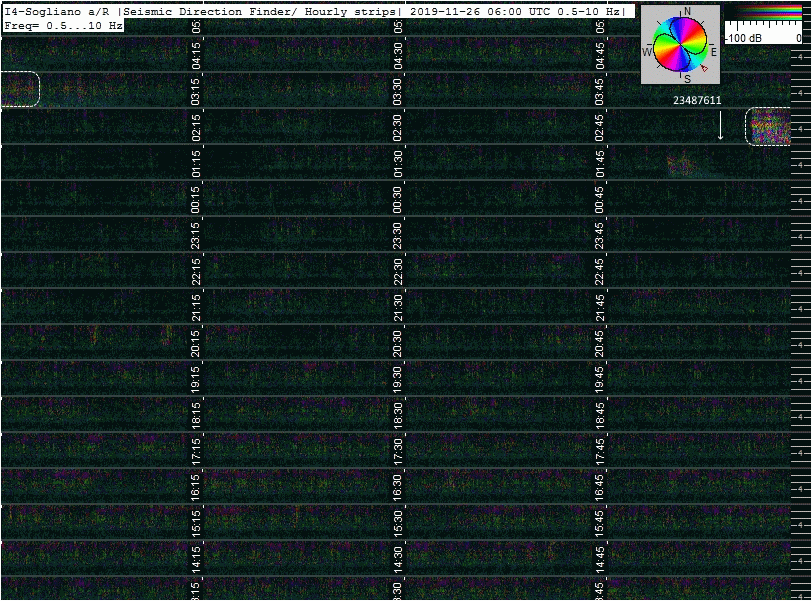
Event-ID: 23487611 marked with white vertical arrow. Almost 5 minutes of signal detected, received a couple of minutes after the event.
Electric field detected with marconi antenna.
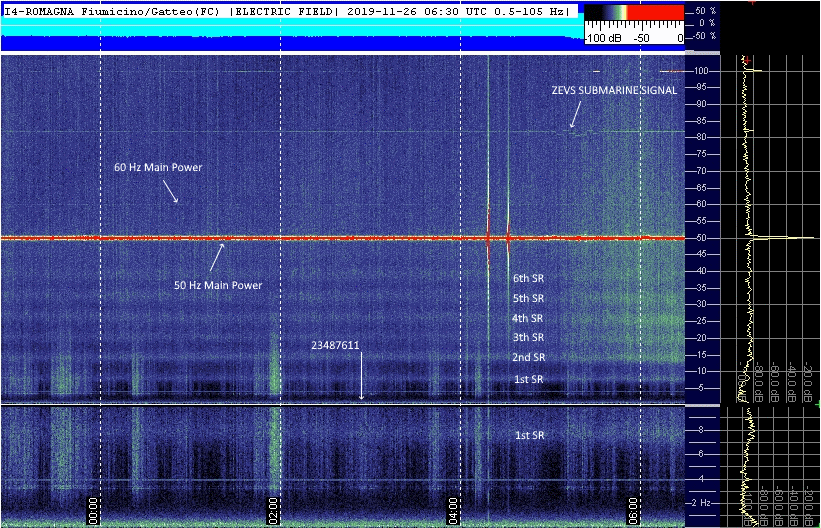
Event-ID: 23487611 marked with white vertical arrow. In electric field spectrogram we can see: six Schumann resonances, ZEVS carrier at 82 Hz with a little part coded with frequency shift modulation, 50 Hz main power, a weak 60 Hz main power. Some increases in background noise at very low frequency, caused by rain, precedes the earthquake. No RF signals correlated with earthquake event.
Multistrip daily view of Electric field, detected with marconi antenna.
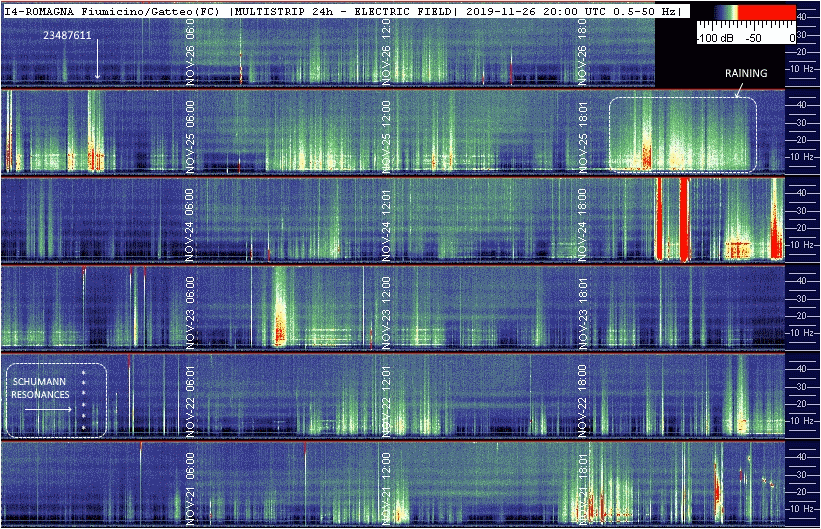
Event-ID: 23487611 marked with white vertical arrow, on top left. Strong and clear Schumann resonances. Continuous increases in background noise, even in the previous days, sometimes up to saturation, due to local rains. No RF signals correlated with earthquake event.
Data analisys from ETNA RADIO OBSERVATORY monitoring station
ERO, 563 km from the event (http://www.vlf.it/etna/etna_live.html)
Radio seismic index: 10.48 dB
Hourly multistrips vertical geophone detection:
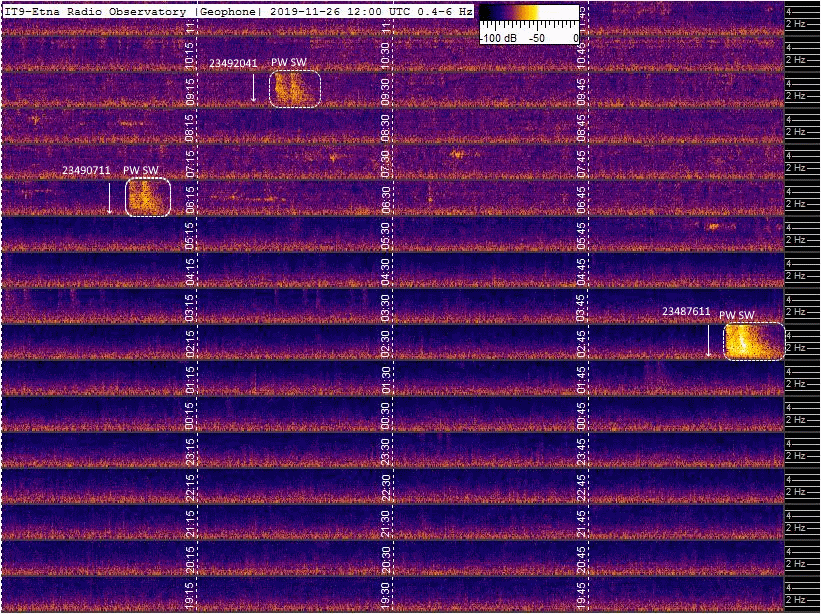
Main event-ID: 23487611 marked with white vertical arrow, on the right side of the spectrogram. The pressure wave and the surface wave here are more confused, given that we are closer to the earthquake, but still distinguishable. Two other events follow in the following hours:
- event-ID: 23490711 Earthquake with magnitude of ML 5.4 on date 26-11-2019 and time 06:08:22 (UTC) Northern Albanian coast (ALBANIA)
- event-ID: 23492041 Earthquake with magnitude of mb 5.3 on date 26-11-2019 and time 09:19:25 (UTC) in region Bosnia and Herz.
Magnetic field detected with two orthogonal aerial loops (http://www.vlf.it/feletti2/idealloop.html), RDF spectrogram:
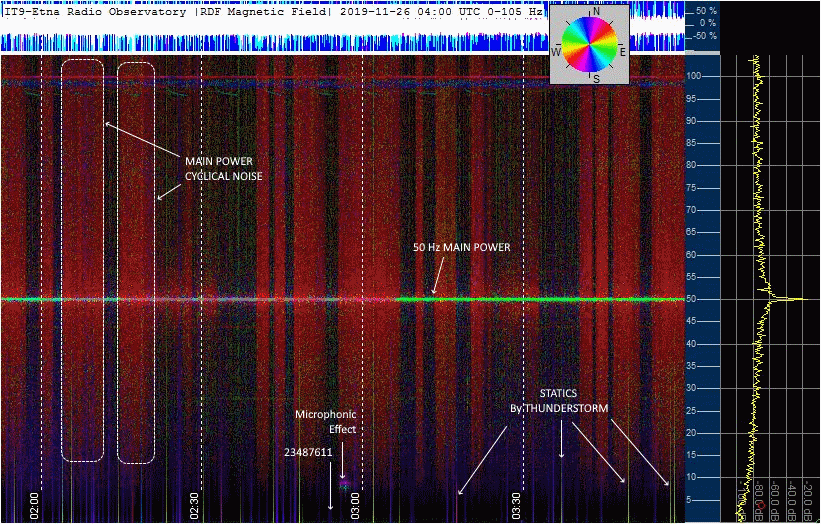
Event-ID: 23487611 marked with white vertical arrow. Very low frequency static from thunderstorm activity. Cyclic noise similar to a white noise, coming from the distribution of electric network. the seismic event is followed after a couple of minutes by a track, always lasting a couple of minutes, and generated by the mechanical vibration of the two loops, which results in a microphone noise. No RF signals correlated with earthquake event.
Hourly multistrips of Magnetic field detected with two orthogonal aerial loops, RDF spectrogram:
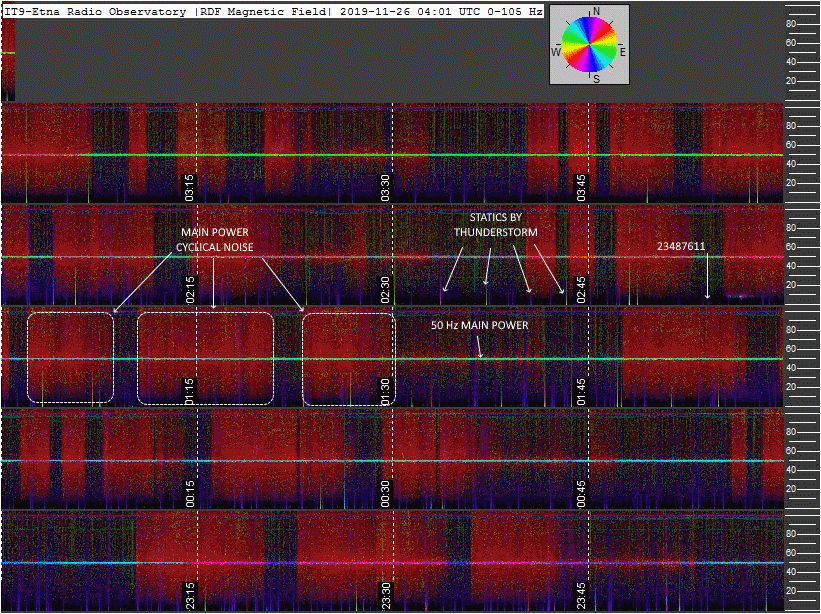
Event-ID: 23487611 marked with white vertical arrow. Here the same considerations of the previous spectrogram are valid. No RF signals correlated with earthquake event.
Magnetic field detected with induction coil.
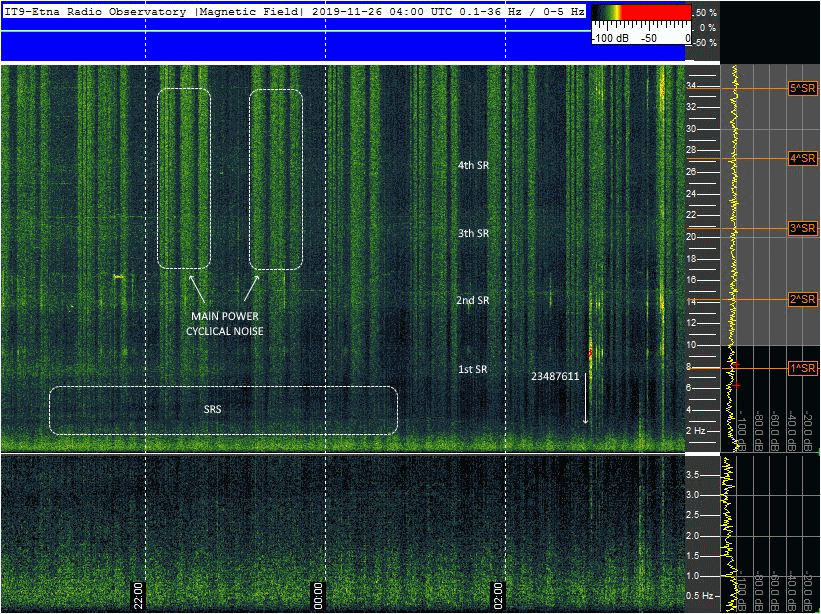
Event-ID: 23487611 marked with white vertical arrow. Always the background noise of the power line that periodically obscures reception. Here, in addition to Schumann resonances, weak SRS (spectral resonance structures) are also visible. The mechanical vibration following the earthquake is also clearly visible here, two minutes after the event. No RF signals correlated with earthquake event.
Multistrips hourly view of Magnetic field, detected with induction coil:
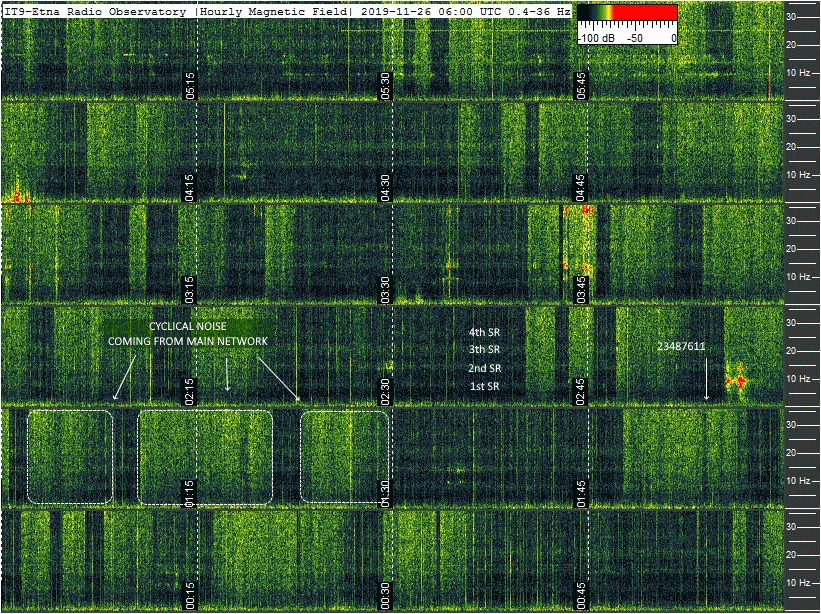
Event-ID: 23487611 marked with white vertical arrow. Same considerations as before. Here, however, the 10 hz microphone effect that follows the earthquake, having lower frequency resolution and greater resolution over time, is visible with more detail. No RF signals correlated with earthquake event.
Multistrips daily view of Magnetic field, detected with induction coil:
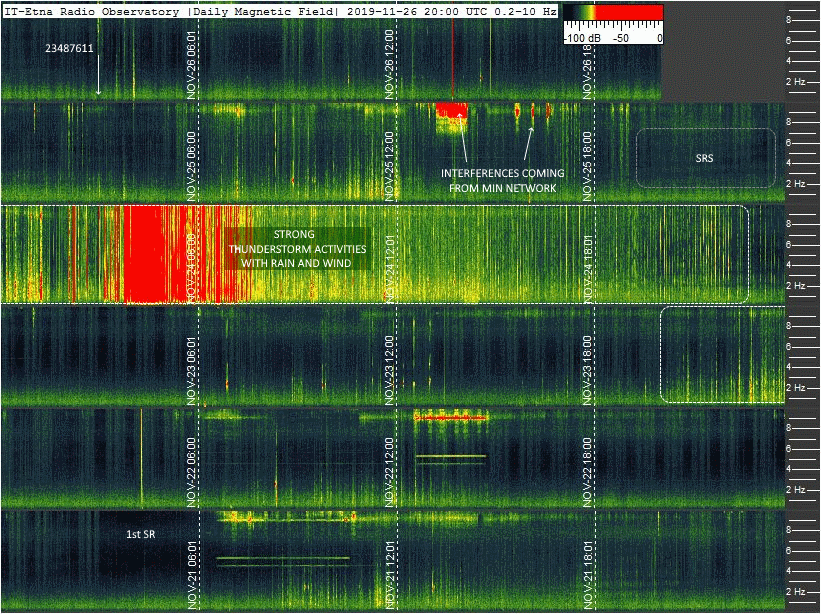
Event-ID: 23487611 marked with white vertical arrow. The first Schumann resonance is almost always visible. Weak SRS precedes the event the night before. Two days before an intense thunderstorm activity almost completely saturates the reception. No RF signals correlated with earthquake event.
CONCLUSIONS
The multiplicity and complexity of the signals normally present, confirms once again, for the radiosismic field, the need for an in-depth analysis, performed on various factors. The presence of a non-homogeneous background noise, of natural origin signals connected to temporary events, and the presence of local disturbances with different times and frequencies, make an approach with the simple measurement of the level ineffective, but requires a more complex representation , given by the spectrograms interpreted with an adequate analysis.
Only the knowledge of the daily periodicity of some signals, of the characteristics of the inevitable anthropic signals and of the shape of some signals that occur occasionally but that have nothing to do with the earthquake, avoid having to recognize as precursors, the signals that precursors are not, leading to incorrect conclusions. In this specific case we can say that this type of analysis has highlighted the lack of precursor signals: they did not emerge from the natural background.
The result is in agreement with what is expected from the calculation by the radiosismic index, which forecasts for a magnitude 6.2 earthquake, a green area around the epicenter, consisting of a maximum distance of 120 km, to have some possibility of receive a very low frequency radio precursor.
THANKS TO:
Thanks to the operators who, for years, keep the workstations active and efficient. They are:
- CMN Cumiana, in North West Italy: Renato ROMERO
- IRA, located NORTHERN CROSS RADIOTELESCOPE of Medicina, North East Italy: Jader MONARI, Renzo CABASSI, Massimo SILVESTRI
- SGL, Sogliano, North East Italy, 644 km far away from epicenter: Federico SCREMIN
- ERO,
Etna Volcano,
Sicily, South
Italy: Rosario
CATANIA,
Salvatore
CAFFO,
Alessandro
LONGO, Luca
CATANIA,
Roberto
MAUGERI,
Alessandro
BONFORTE.
Return to http://www.vlf.it home page